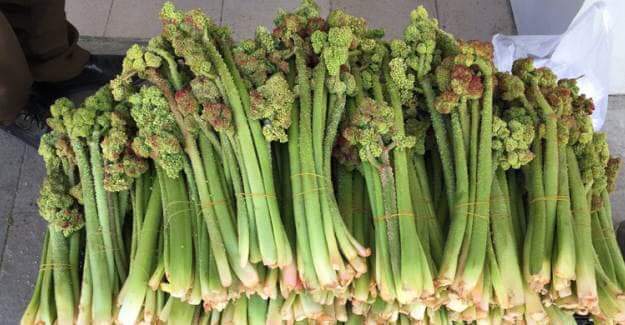There are some plants in Kurdistan that are considered to be very beneficial among people. In other words, these kinds of plants are a part of Kurdish culture and not even they are popular for their beneficial features but also they have cultural meanings for people. One of these plants is rhubarb. Rhubarb has a special place in Kurdish culture and the Kurds enjoy it very much. This is why in many parts of Kurdistan people call this plant “Kurdish banana” or “alpine banana”. This shows the importance of this plant among Kurds. Many kinds of plants are beneficial for health, some of them even have medicinal benefits but some kinds of plants have become a part of a particular culture. Particularly in Kurdistan, this is a common thing to pay a great deal of attention and significance to a kind of plant. Rhubarb is one of these plants.
Rhubarb is a plant that grows in the spring season over the mountains of Kurdistan and it is available in almost all parts of Kurdistan. Rhubarb is a kind of plant but it can be regarded as a fruit, too. This plant starts to grow in spring and it is mostly found in high mountains among rocks. Where the rhubarb can grow, other kinds of plants do not grow, i.e. this plant is naturally grown.
Although most people consume this plant like a fruit, it can also be used like pickles. This plant should be peeled off like most of the fruits first to be ready for eating. Some people like to barbeque it over the fire. Rhubarb can stay fresh for 10 days at most and it gets dry very quickly.
In Kurdistan people eat the rhubarb and they don’t use the leaves; however, in Europe apparently, they use its leaves for medicinal purposes, in cakes and syrups or cocktails and they do not eat the fruit part. The Europeans usually plant it in their gardens and sell it to the market.
In Chinese medical books, it is mentioned as Barbaric vessels because when the Tibetans and Mongolians invaded China they took rhubarb to China for the first time. This plant was transferred to Europe in 1600 A.D. In 1800 the English people began to plant it in their gardens; they used it both as an edible product and a beautiful plant. In 1900 it was taken to North America. Nowadays European countries like the Netherlands, Germany, Italy, Britain, etc. plant it for trading, as an edible product, and for decoration.
What are the benefits of rhubarb?
Eating rhubarb can increase appetite, energize the body, decrease intestine and stomach gas, make it easier to urinate, and help with constipation but overeating causes diarrhea.
Jam:
Rhubarb can be used in a mixed jam with other fruits like rhubarb and strawberry, rhubarb and cherry, rhubarb and orange, kiwi and rhubarb, and many other kinds of fruits, too.
The recipe for rhubarb jam:
First, the rhubarbs should be peeled off and rinsed. Pour some sugar on it and keep it in the fridge over a night. Later any kind of desirable fruit can be added to it. Add some water and sugar to it and cook it. After it is done let it cool and finally store it in glass jars.
Rhubarb can also be consumed in this way:
Peel off the rhubarb and chop it. Pour a little oil into a pan and add the rhubarb slices to it. Fry it for a short time. After it is done and the rhubarb got soft add other kinds of spring plants to it and let it cook with some eggs. In some food recipes where chervil is used, rhubarb can be used instead of chervil.
Like the syrups that are made of fruits in cakes and desserts, rhubarb syrup can also be used in the same way. Clean the rhubarb and chop it. Put it in boiling water for 15 minutes to cook. After it got softer, strain the syrup and let it cool. After it got cool enough the syrup can be used in any cake or dessert.
It is believed that rhubarb especially its vessel parts of it can help with diabetes. Mostly the East and North parts of Kurdistan believe so. In addition, often doctors and medical experts suggest that people who suffer from diabetes use rhubarb but it is not proven yet.









